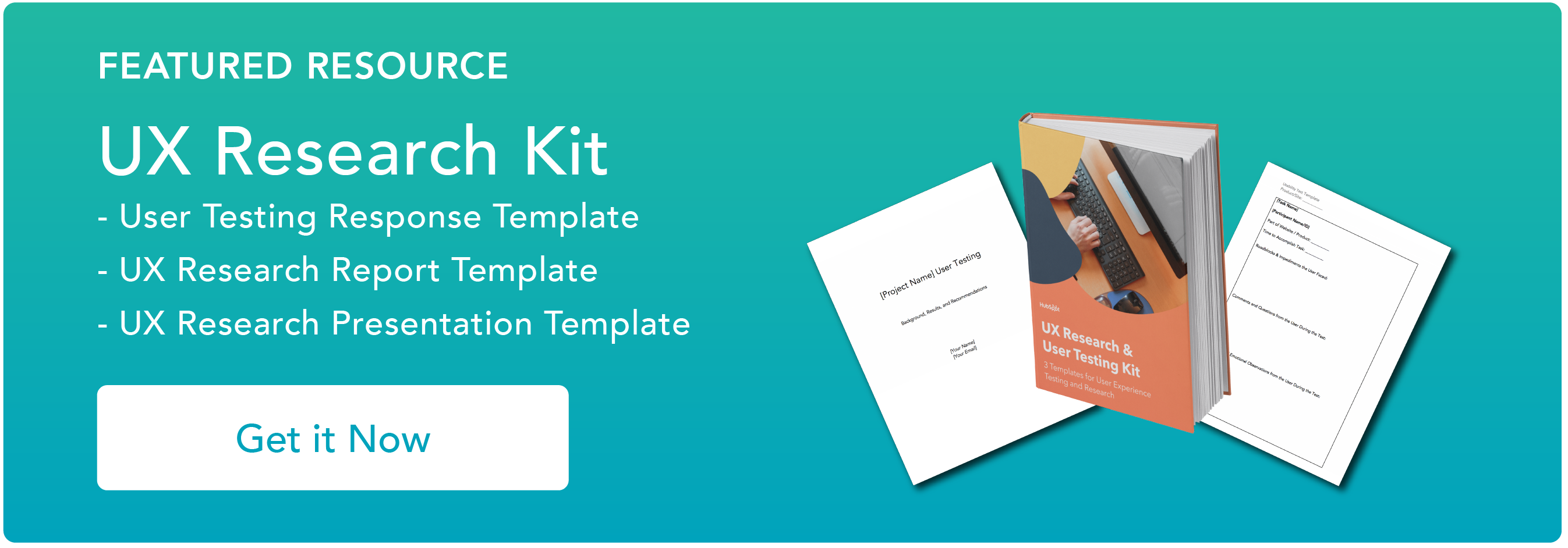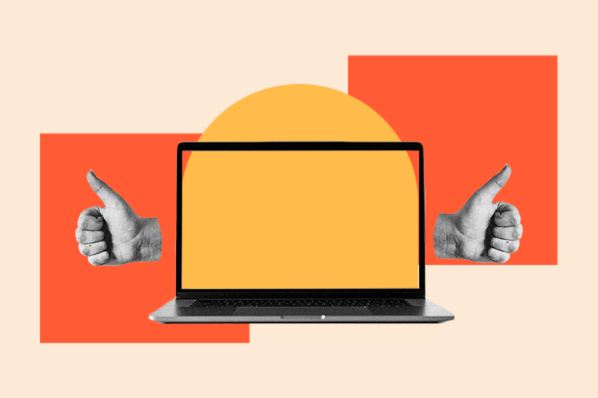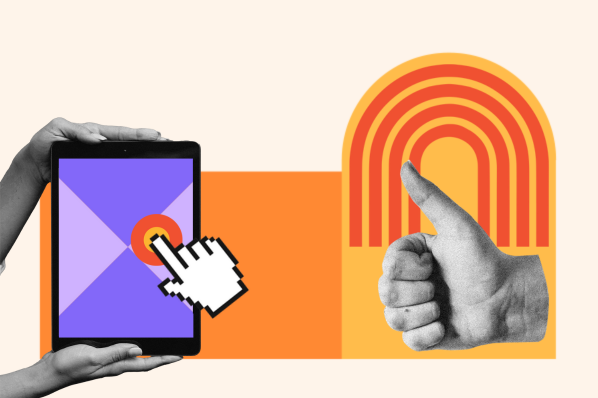UX goals are essential for this process because they help web designers understand the purpose of individual pages alongside the overall user journey. They guide me toward metrics that enable me to understand what’s working and what needs to be upgraded.
So, what are UX goals? And how should they be used to guide design?
6 Essential UX Goals

When a physical product doesn’t look good or function well, we don’t question why it doesn’t sell or why customers are switching to a competitor. It’s obvious.
UX for a digital product is no different. When consumers spend money, they expect a product that works as advertised, firstly, and that is enjoyable and easy to use. Good UX is the difference between getting people in the door and making sure they stick around.
I’ve often worked with SaaS companies where product and marketing teams are scrambling to understand why conversion rates are low, or customer churn is high. Almost always, the in-product or website experience is the direct culprit — or playing a pivotal role at the very least.
Research from data.ai shows that 90% of people have abandoned an app due to poor performance.
In my experience, addressing UX issues has always increased conversion rates, whether it’s for e-commerce purchases, website lead generation, or in-app purchases. It’s true that the impact varies since other factors can be at play, but it makes a difference without fail.
Setting and meeting UX goals ensures you’re delivering a product and online experience that leaves customers satisfied. It means the product functions well, and it’s also a pleasure to use.
Things are easy to find, and your users are not as easily stolen away by a competitor. Customers become less price-sensitive because they know the value of having a well-designed digital product at their fingertips.
But “make something beautiful that functions well and drives higher conversions” isn’t a particularly useful goal. Designers need to know how to bring that to what they’re building on a more practical level.
So, let’s take a look at some UX goals that are essential to user satisfaction.
1. Always aim to satisfy the user.
If pleasing the user isn’t at the center of every design decision you make, you’re doing it wrong.
A debate I have quite often is about implementing pop-ups on websites. Do they drive conversions? Yes, mostly.
But a lot of times, they’re implemented in such a way that you could actually be driving more people away from your site than you’re converting.
That’s because when the focus is purely on conversions and not how your design choice is affecting the user journey, you’ll inevitably frustrate your customers. Everyone has visited a website where something pops up every time you try to scroll or navigate to a new page.
Even worse, the offer is rarely valuable, and they’ve made it impossible to navigate away and back to what actually brought you to the site in the first place.
When I implement pop-ups, it’s always to enhance the user journey. Taking this approach almost always results in higher conversion rates anyway.
For example, is a full-page pop-up necessary? Or do I have an offer that’s so enticing, a small bottom-corner slider or unobtrusive hello bar is enough to drive action? And if a user closes the pop-up, am I respecting their decision and making sure they don’t see it again?
There are tons of ways to measure user satisfaction, from Net Promoter Score (NPS) to website feedback surveys. Some of the metrics you can use to measure user satisfaction without getting direct feedback include usage metrics or behavioral metrics like bounce rate or “rage clicks.”
2. Make your product as easy to use as possible.
Customer success teams spend a lot of time curating knowledge bases so users have resources that help them use the product effectively.
But, a good user experience goal is for users to need that knowledge base as little as possible. Instead, you should aim to provide a UI and UX that guides a user seamlessly from one action to another.
Intuitive products earn higher conversion and retention rates, and it’s something you’ll see regularly mentioned in reviews for tools, apps, and software across all kinds of niches.
Complex interfaces and tasks that take ten steps to complete when they could take two experiences are a recipe for user frustration.
And it starts from your initial website UX, right through to the registration/sign-up process and everything that happens within the app or product.
Of course, some apps or tools will naturally have something of a learning curve, no matter how good the design is. But you should aim to leverage UX to make this learning curve as seamless as possible.
In one rather complex piece of B2B software, I worked with the product team to implement friendly tooltips, which included links to further knowledge base resources if they were needed. Other options include onboarding tours, in-app chatbots, or a combination of all of the above.
When measuring this goal, metrics like time to complete tasks, error rates, and support requests can all help you to understand where your UX is creating a more complex and confusing process than necessary.
3. Design for all users.
Accessibility is absolutely critical to good UX in 2024 and beyond. Not only does it widely expand your potential user base, but it provides a positive experience for users of all abilities and helps your product maintain a competitive edge.
A good place to start is the Web Content Accessibility Guidelines (WCAG). From the color palette of your design to metadata structure and easy integration with accessibility tools, there’s plenty you can do to provide an accessible UX.
In terms of measurement, the best course of action is regular audits to make sure you’re compliant with WCAG and checking all the accessibility boxes you can. There are plenty of free tools available to help you do this for websites and apps alike.
4. Make it inviting.
Just like welcoming shoppers to a brick-and-mortar store, your app or site should feel like a pleasant place to be, one that makes users want to browse through the shelves and racks and see what you have to offer.
Some design concepts take the idea of “attractive” a little too far and clutter the interface with bold colors and larger-than-life elements.
One of the first things I’ll do with websites that I find in this state is strip everything back to expose plenty of whitespace and minimize elements and navigation. Then, I can assess how the brand can be applied effectively without overwhelming the user and build back up from there.
Why is this important? Clutter makes it difficult to actually see anything. Just like overflowing shelves or racks stuffed with clothes, it becomes difficult to pick out the area a user wants to navigate to or an item they should click on.
It’s not just about layout, either. Everything from button color to CTA text and on-page copy contributes to making your product inviting to users. You want to guide them into your space with a welcoming presence without overwhelming them.
Measuring how inviting your UX is can take multiple different metrics into account. You can run visual appeal surveys or focus groups and look at indicators like engagement rate or bounce rate and on-page heat maps to get a sense of this.
5. Reduce the work for your users.
We mentioned task completion rates earlier, and this is an essential goal for positive UX. Your site or product should aim to make it as simple as possible for users to take action — in other words, your product should be efficient.
On one B2B software site, I had a CTA button in the navigation to “Learn More.” This took users to a page with multiple options to start a trial, book a demo, or get in touch with the team. Each of these options further opened up onto separate pages depending on what the user clicked. It was a lot of work!
Instead, I looked at which of these actions was converting the highest. Turns out, nobody was choosing to get in touch with the team. So, we removed that option completely.
Next, I added the two buttons (“Start for Free” and “Book a Demo”) to the navigation bar, so users could choose the action and complete it in just two steps. The free trial conversions jumped by 7%, and the demo bookings rose by 11% in the first month.
This UX goal is all about ensuring you’re not making users work any harder than they have to. Make actions and workflows clear and straightforward, while still giving users easy options where it makes sense.
As you can see in this example, website conversion rates are a great metric to look at here. In products and apps, you can measure task completion rates and time to task completion to assess UX efficiency.
6. Stop hiding things.
There’s no doubt that there’s a balance to be struck between simplifying your UX while still making sure users can easily find what they’re looking for on your site.
Some websites are packed with information and pages by nature, and some products are in-depth and built for highly technical expertise. So, oversimplifying your UX can lead to a new problem: users can’t find anything.
A familiar favorite for designers and devs is the Three Click Rule. This means that users should be able to reach any page on your site within three clicks away from the homepage. But when you’ve got hundreds of product pages or downloadable resources to share, that’s easier said than done.
One of the ways I solve this problem is to bucket everything effectively within the navigation and use dropdowns or flyout sub-navigation to further guide users to what they need.
For example, if you produce a lot of content, you might have a main “Resources” tab in your menu. The flyout can include items like eBooks, webinars, podcasts, etc.
Another good workaround is a well-functioning search bar. This is particularly useful in apps or knowledge hubs where users might be looking for something very specific.
Sites That Meet Their UX Goals
Babbel
This well-known language-learning app aims to guide users through their learning journey simply and efficiently.
%20(2)-1.webp?width=450&height=1000&name=Untitled%20(1)%20(2)-1.webp)
Babbel’s UX ensures users can jump right back into their learning journey as soon as they open the app, without having to scroll through lessons. The copy and calls-to-action are simple, and branding and colors are used effectively without overwhelming.
Apple
Apple provides a lot of products and a lot of services. With this much going on, they need to provide a UX that puts everything at the user’s fingertips, no matter what they’re looking for on the website.
First off, I really like the way Apple brings strong and sleek design to their site in a way that reinforces brand recognition. But to reach the goal of making the site’s UX reduce work for users and provide an efficient experience, they provide streamlined navigation.
The main nav is grouped by product and service, but flyout menus further guide the user right where they need to be.
-4.webp?width=650&height=366&name=Untitled%20(15)-4.webp)
IKEA
There’s no doubt that e-commerce stores have it harder than most when it comes to meeting UX goals. There are often thousands of pages to manage and multiple different user journeys to take into account.
IKEA is one e-commerce store that I’ve always felt meets its UX goals very well. It’s a complex site with thousands of products, and yet it never feels difficult to find anything.
IKEA does provide extensive menu options and an excellent search function to help reduce complexity and time to action. But what I really like is the way they leverage the homepage to start users on specific journeys.
For example, kids' storage options or living room refurbs are presented with appealing design and straightforward copy, inviting the user to explore further.
-3.webp?width=650&height=368&name=Untitled%20(16)-3.webp)
Guide Users Through Product Journey With UX Goals
UX goals are there to guide how you build a UI, the design of on-page elements, and how you can leverage navigation and design to guide users through their product journey while maximizing conversions along the way.
Without UX goals in place, designing a website or digital product can feel a bit like a shot in the dark. Having them in mind from the start reduces time spent later on re-working the user experience and ensures you’re converting users as soon as they find you online.
User Experience
.png?width=112&height=112&name=Image%20Hackathon%20%E2%80%93%20Square%20(10).png)
.png)
-3.webp?width=650&height=368&name=Untitled%20(14)-3.webp)


![How to become a UX designer, a step-by-step guide [expert tips]](https://53.fs1.hubspotusercontent-na1.net/hubfs/53/become-a-ux-designer-1-20240731-321437.webp)


![How to Add a Parallax Scrolling Effect to Your Website [Examples]](https://53.fs1.hubspotusercontent-na1.net/hubfs/53/scroll-Aug-11-2023-05-24-08-8793-PM.png)

![20 UX Design Examples Hand-Picked by Experts [With Analysis]](https://53.fs1.hubspotusercontent-na1.net/hubfs/53/ux-design-examples-1-20250404-8425368.webp)
